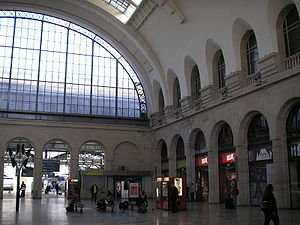
Sustainable lighting
Encyclopedia

Lighting
Lighting or illumination is the deliberate application of light to achieve some practical or aesthetic effect. Lighting includes the use of both artificial light sources such as lamps and light fixtures, as well as natural illumination by capturing daylight...
designed with energy efficient light sources. The most sustainable source of lighting is daylight
Daylight
Daylight or the light of day is the combination of all direct and indirect sunlight outdoors during the daytime. This includes direct sunlight, diffuse sky radiation, and both of these reflected from the Earth and terrestrial objects. Sunlight scattered or reflected from objects in outer space is...
, other forms are solar lamp
Solar lamp
A solar lamp is a portable light fixture composed of a LED lamp, a photovoltaic solar panel, and a rechargeable battery.Outdoor lamps are used for lawn and garden decorations. Indoor solar lamps are also used for general illumination .Solar lights are used for decoration, and come in a wide variety...
s harvesting daylight and lighting controlled by occupation sensor
Motion detection
Motion detection is a process of confirming a change in position of an object relative to its surroundings or the change in the surroundings relative to an object. This detection can be achieved by both mechanical and electronic methods...
s. Furthermore technologies such as light-emitting diode
Light-emitting diode
A light-emitting diode is a semiconductor light source. LEDs are used as indicator lamps in many devices and are increasingly used for other lighting...
s can be used to drastically reduce the energy requirement for energy. Part L of the UK lighting regulations, contains criteria that effects efficient lighting design.
Both day lighting and electric light
Electric light
Electric lights are a convenient and economic form of artificial lighting which provide increased comfort, safety and efficiency. Most electric lighting is powered by centrally-generated electric power, but lighting may also be powered by mobile or standby electric generators or battery systems...
ing can be considered natural extensions of the architecture
Architecture
Architecture is both the process and product of planning, designing and construction. Architectural works, in the material form of buildings, are often perceived as cultural and political symbols and as works of art...
, and not just as something installed to enable people to see their task.
Satisfaction surveys
Customer satisfaction
Customer satisfaction, a term frequently used in marketing, is a measure of how products and services supplied by a company meet or surpass customer expectation...
indicate that people prefer rooms that are day lit to interiors dominated by electric lighting. In addition, the use of daylight can significantly reduce a building’s use of energy
Energy
In physics, energy is an indirectly observed quantity. It is often understood as the ability a physical system has to do work on other physical systems...
. Post-occupancy research
Post occupancy evaluation
Post Occupancy Evaluation has its origins in the United States and has been used in one form or another since the 1960s. Preiser and colleagues define POE as...
indicated that the success of a scheme in reducing energy is not determined solely by the quantity of light from windows, but also on the efficiency and control of the electric lighting and that the users of the building were motivated towards energy management
Energy management
Energy Management is a degree offered by the University of Oklahoma's Michael F. Price College of Business. The OU degree program was the first of its kind, emerging in 1958 as the Petroleum Land Management program before becoming the Energy Management program in 1999.It is business-specific, with...
.
In cloudy climate
Climate
Climate encompasses the statistics of temperature, humidity, atmospheric pressure, wind, rainfall, atmospheric particle count and other meteorological elemental measurements in a given region over long periods...
s, diffuse light from the sky is the main source of lighting. At the site planning stage, a sufficient area of sky must be made visible to give good interior lighting.
People’s needs and preferences to sunlight
Sunlight
Sunlight, in the broad sense, is the total frequency spectrum of electromagnetic radiation given off by the Sun. On Earth, sunlight is filtered through the Earth's atmosphere, and solar radiation is obvious as daylight when the Sun is above the horizon.When the direct solar radiation is not blocked...
dependent on the type of building – incoming sunlight can give warmth and brightness but can also cause glare and thermal discomfort. The designer must to analyses the clients’ requirements in advance to determine which parts of a building would benefit from direct sunlight. Once the day lighting has been assessed, electric lighting needs to be designed to complement the daylight; where necessary electric light will take over when the daylight fades. Zones can be considered relative to the daylight distribution – without this there will be a tendency for the lights to be in all the time. Electric lighting can also be integrated within the architecture. Daylight and the aesthetics
Aesthetics
Aesthetics is a branch of philosophy dealing with the nature of beauty, art, and taste, and with the creation and appreciation of beauty. It is more scientifically defined as the study of sensory or sensori-emotional values, sometimes called judgments of sentiment and taste...
can be considered as well as the installation into the buildings fabric and lighting effect.

